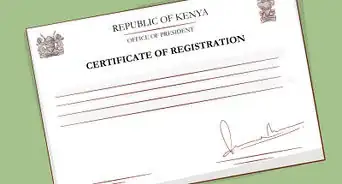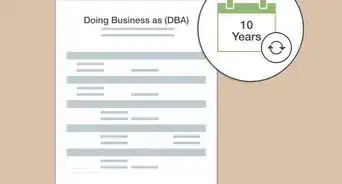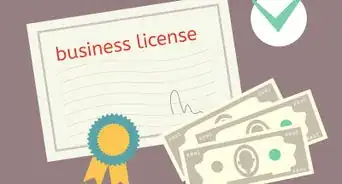This article was co-authored by Dave Labowitz. Dave Labowitz is a Business Coach who helps pre-entrepreneurs, solopreneurs/entrepreneurs, and team leaders start, scale, and lead their businesses and teams. Before beginning his coaching career, Dave was a startup executive who spent over a decade building high-growth companies. Dave’s “path less traveled” life includes adventures such as dropping out of high school, co-authoring a book in the Smithsonian Institute, and getting his MBA at Pepperdine’s Graziadio Business School.
There are 14 references cited in this article, which can be found at the bottom of the page.
wikiHow marks an article as reader-approved once it receives enough positive feedback. In this case, 100% of readers who voted found the article helpful, earning it our reader-approved status.
This article has been viewed 178,821 times.
A limited liability company (LLC) is a hybrid of a corporation and a partnership. Like a corporation, it protects owners from lawsuits and bankruptcy. Like a partnership, profits and losses can be divided among the owners any way they want. An LLC’s owners are called “members,” and in many states you can have a one-person LLC. To form your LLC, pick a business name and complete necessary paperwork with your state’s Secretary of State’s office.[1]
Steps
Choosing a Business Name
-
1Pick a memorable name. Make sure your name is something consumers will remember. It should suggest important qualities about your business and inspire people to use your products or services. For example, “Akron Lawn Care” is boring. By contrast, “Rolling Meadows Lawn Treatment, LLC” tells consumers they can have a lush lawn.
-
2Follow your state’s laws on business names. Most states will require that you have an appropriate designator at the end of the name, such as “Limited Liability Company,” “Limited Company,” or an abbreviation (such as “LLC,” “Ltd. Liability Co.,” etc.)[2]
- States will also prohibit certain words, such as Bank, Insurance, or Trust. Check your state’s laws for a full list.
Advertisement -
3Check if the name is available. You can’t use a name if another business is using it or a similar name in your state. In most states, you can search a business name database at your Secretary of State’s website.
- You can’t use a name if someone else has already trademarked it. Search the federal trademark database at https://www.uspto.gov/trademarks-application-process/search-trademark-database.
- If you want a website, make sure the URL is available. Most businesses have their name as part of the URL.
-
4Reserve your business name. In most states, you can reserve your business name for a short period of time, usually 30-60 days. This gives you time to file your other paperwork. You’ll have to pay a fee to reserve the name.[3] Complete the necessary paperwork with your Secretary of State office.
-
5Trademark your name, if you want. A business name can also qualify as a trademark if you use it to distinguish your goods or services. For example, if you sell a product with your business name blazoned on the packaging or the product, then your name is probably a trademark. You can file your trademark online.
- You have rights whether you trademark your name or not. However, filing a federal trademark gives you the ability to sue in federal court when someone illegally uses your trademark.[4]
Organizing Your LLC
-
1Choose your management structure. You can have a member-managed or manager-managed LLC. A member-managed LLC is run by all of its members. By contrast, a manager-managed LLC has passive investors who do not take part in running the business.[5] If you’re a small LLC, chances are you’ll be member-managed.
-
2Pick a registered agent. If someone wants to sue your LLC, they need to serve papers on someone. This person will be your registered agent. One of the LLC founders can serve as the registered agent, or you can pay a company to serve as your agent.[6]
-
3File your articles of organization. This paperwork goes by different names, depending on your state. For example, it might be called a “certificate of formation” or “certificate of organization.” Regardless of the name, you must file the paperwork with your Secretary of State.[7]
- Your state should have “fill in the blank” articles of organization to use. You can download them online.
- In some states, you can file your articles of organization online.
- You’ll need to pay a filing fee, which will vary by state. However, it shouldn’t be more than a couple hundred dollars.[8]
-
4Draft your operating agreement. This document is the operating manual for your business. Your state probably won’t require that you file your operating agreement, but you should keep it at your principal place of business. A solid operating agreement should contain the following:[9]
- A description of your business purpose.
- An identification of each member and their ownership percentage.
- The rights and duties of the members.
- An explanation of the members’ voting power. You can decide to give each member an equal vote or weight the vote according to ownership percentage.
- An explanation of how profits and losses will be distributed.
- Your rules for calling and holding meetings.
- A buy-sell agreement, which explains what happens if a member dies, quits, or is removed from the LLC.
-
5Publish a notice. In some states, you need to publish your intent to create an LLC in a local newspaper. Typically, the notice must run for several weeks, after which you submit an affidavit of publication as proof.[10] Check with your Secretary of State’s office.
-
6Obtain your Employer Identification Number (EIN). Your EIN is your LLC’s federal tax ID. You’ll need this number to pay federal taxes and to get a bank account. Obtain your EIN online at https://www.irs.gov/businesses/small-businesses-self-employed/apply-for-an-employer-identification-number-ein-online. You can get your EIN for free.[11]
-
7Register with your state tax office. Contact the office and check what state taxes you must pay. Many LLCs must pay sales tax, use tax, unemployment tax, and employee withholding. Contact the appropriate tax office to register your LLC.
Taking Next Steps
-
1Obtain required licenses and permits. Depending on your business and where it is located, you might need additional licenses or permits before you can open your doors.[12] For example, food and beverage businesses often need multiple permits or licenses. Check with your county clerk.
- You can also contact your nearest Small Business Development Center (SBDC). A counselor there can help you identify what licenses and permits you need. Find your nearest SBDC at https://www.sba.gov/tools/local-assistance/sbdc.
-
2Open a bank account. Keep your business and personal banking separate. If you mix funds, then you might lose your limited liability protection against lawsuits. Shop around for a bank that offers what you need. You can open the account in-person or online and will need your EIN, articles of organization, and possibly a resolution giving you permission to open the account.[13]
-
3Get business insurance. An LLC will protect you personally from lawsuits, which means someone can’t come after your home or car if they get a court judgment against you. However, you’ll still want to get general business liability insurance. Consult with an insurance broker to find appropriate policy.
-
4Find space for your business. If you want to run your business from home, check whether your neighborhood’s zoning laws allow it. Stop into the local zoning office and check. You might need a zoning permit.
- You can find commercial space on websites such as Loopnet.com or in your local newspaper. Commercial rents are usually calculated based on the square footage.[14]
-
5Hire employees legally. Within 20 days of hiring an employee, you must report them to your state’s New Hiring Office. Generally, you’ll report new hires online, so create an account with the appropriate office.
- You also might need to buy workers’ compensation insurance. Check with your state’s Department of Labor to find a licensed insurance agent.
-
6Get professional help for your business. Running an LLC can be complicated, and before long you might grow so large that you can’t do everything yourself. Consider hiring professionals to help you untangle some of the knots.
- Business lawyer. A lawyer can represent you in court, but they can also help you understand your reporting requirements as an LLC. Obtain a referral from your nearest bar association.
- Accountant. An accountant can help you at tax time. They can also serve as a business advisor who can assess any plans for growth.
- Bookkeeper. A bookkeeper enters your daily business transactions. You might want to use software when starting out, but eventually it might make more sense to hire someone.
-
7Decide how you want to be taxed. The IRS does not recognize the LLC form. Instead, if you have at least two members, your LLC will be treated as a partnership. However, you can file Form 8832 and elect to be treated as a corporation for tax purposes.[15] Discuss these options with your lawyer and accountant.
- If you have a one-person LLC, you will be treated as a sole proprietor, which means you will report profits and losses on your personal tax return. However, you can file Form 8832 and choose to be treated as a corporation.
-
8File an annual report, if necessary. In many states, you must file an annual report, which will differ depending on where you’re located.[16] For example, in some states, you merely update basic information, such as your address and the name and address of one member. You must also pay an annual fee.
- However, other states will want more detailed financial records. You should check with your Secretary of State.
Community Q&A
-
QuestionI work from home and want to start a business DBA. Do I have to register with the county or city I live in?
 Community AnswerContact the Secretary of State's Office in your state. You may also contact the Register of Deeds Office in your county to assist you with your questions.
Community AnswerContact the Secretary of State's Office in your state. You may also contact the Register of Deeds Office in your county to assist you with your questions.
References
- ↑ https://www.irs.gov/businesses/small-businesses-self-employed/limited-liability-company-llc
- ↑ https://www.forbes.com/sites/allbusiness/2017/01/18/10-key-issues-in-setting-up-an-llc/#6daf4827633d
- ↑ http://www.nolo.com/legal-encyclopedia/form-llc-how-to-organize-llc-30287.html
- ↑ https://www.fr.com/news/top-10-benefits-of-us-trademark-registration/
- ↑ http://www.nolo.com/legal-encyclopedia/member-managed-llcs-versus-manager-managed-llcs.html
- ↑ https://www.forbes.com/sites/allbusiness/2017/01/18/10-key-issues-in-setting-up-an-llc/#6daf4827633d
- ↑ http://www.nolo.com/legal-encyclopedia/form-llc-how-to-organize-llc-30287.html
- ↑ http://guides.wsj.com/small-business/starting-a-business/how-to-start-an-llc/
- ↑ https://www.legalzoom.com/articles/how-to-draft-an-llc-operating-agreement
- ↑ http://www.nolo.com/legal-encyclopedia/form-llc-how-to-organize-llc-30287.html
- ↑ https://www.forbes.com/sites/allbusiness/2017/01/18/10-key-issues-in-setting-up-an-llc/#6daf4827633d
- ↑ http://www.nolo.com/legal-encyclopedia/form-llc-how-to-organize-llc-30287.html
- ↑ https://www.forbes.com/sites/allbusiness/2017/01/18/10-key-issues-in-setting-up-an-llc/#6daf4827633d
- ↑ http://smallbusiness.findlaw.com/business-operations/commercial-property-rentals.html
- ↑ https://www.irs.gov/businesses/small-businesses-self-employed/limited-liability-company-llc
- ↑ http://www.nolo.com/legal-encyclopedia/50-state-guide-annual-report-tax-filing-requirements-llcs
-in-the-USA-Step-1-Version-2.webp)
-in-the-USA-Step-2-Version-2.webp)
-in-the-USA-Step-3-Version-2.webp)
-in-the-USA-Step-4-Version-2.webp)
-in-the-USA-Step-5-Version-2.webp)
-in-the-USA-Step-6-Version-2.webp)
-in-the-USA-Step-7-Version-2.webp)
-in-the-USA-Step-8-Version-2.webp)
-in-the-USA-Step-9-Version-2.webp)
-in-the-USA-Step-10-Version-2.webp)
-in-the-USA-Step-11.webp)
-in-the-USA-Step-12.webp)
-in-the-USA-Step-13.webp)
-in-the-USA-Step-14.webp)
-in-the-USA-Step-15.webp)
-in-the-USA-Step-16.webp)
-in-the-USA-Step-17.webp)
-in-the-USA-Step-18.webp)
-in-the-USA-Step-19.webp)
-in-the-USA-Step-20.webp)





























































